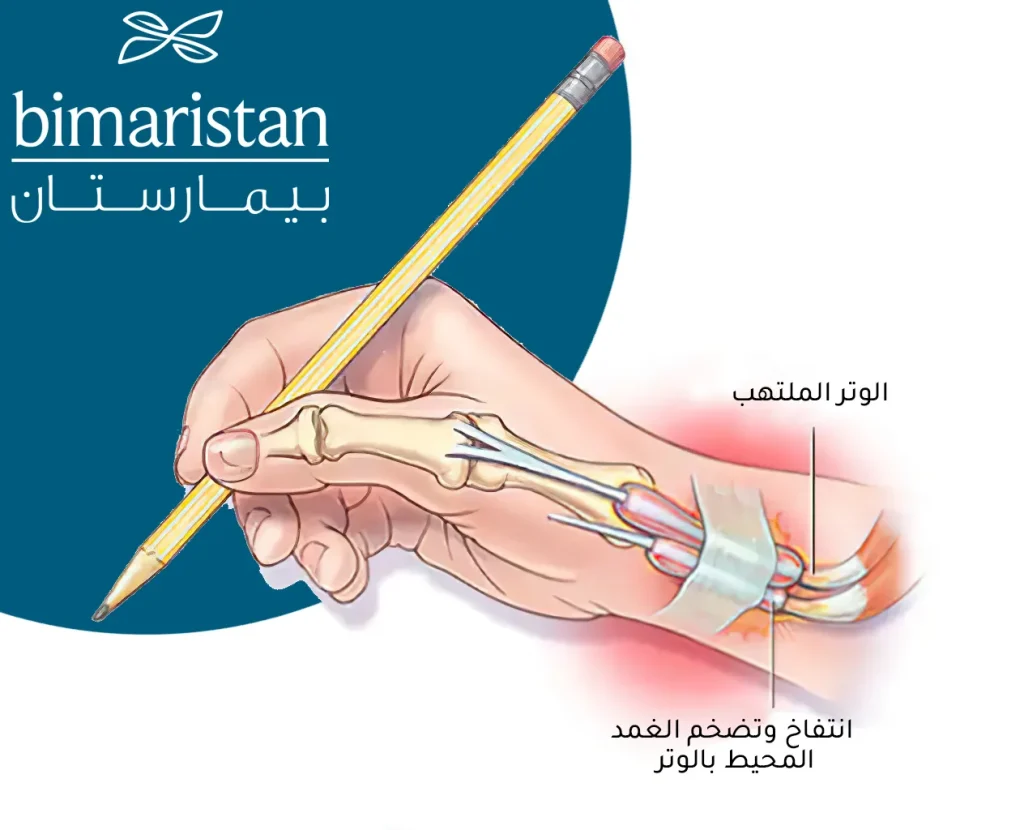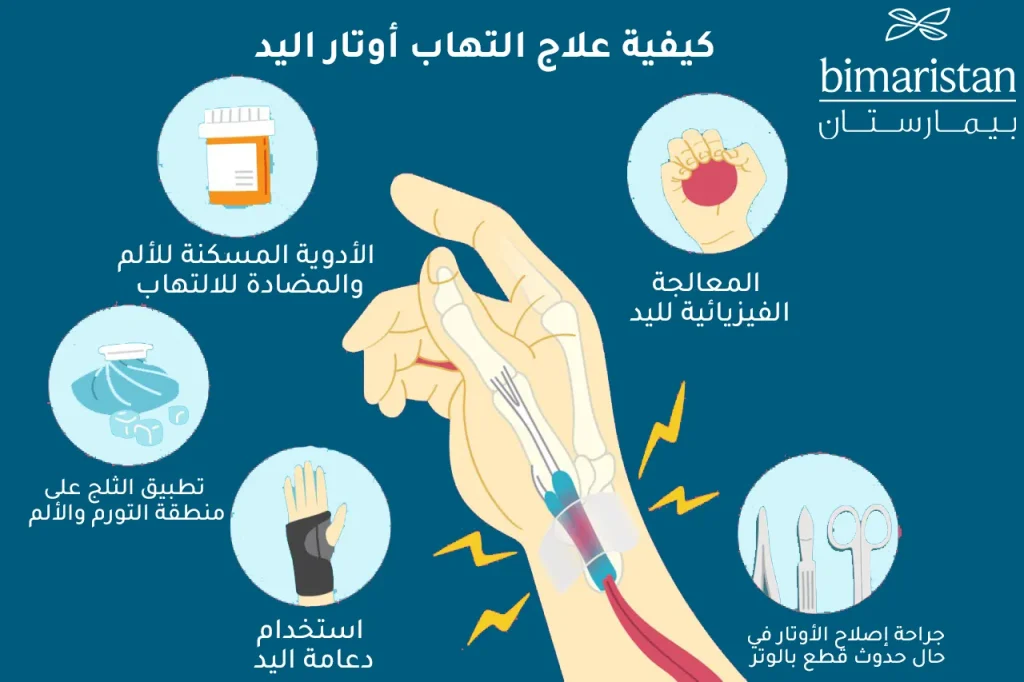عندما تصاب بالتهاب أوتار اليد قد تشعر بألم وحرقة عند تحريك يدك المصابة وقد يتطور الالتهاب ليصبح الألم مستمر عند الراحة، تعرف على كيفية علاج التهاب اوتار اليد.
الألم هو من أبرز أعراض التهاب الأوتار في اليد ولكنه ليس العرض الوحيد، فكثيراً ما يعاني مرضى التهاب الاوتار بالشعور في خدر أو نمل عند تحريك المعصم أو الأصابع الخمسة وخاصة إصبع الإبهام وذلك لوجود وتر مهم للإبهام يعرف باسم “وتر دو كورفان” والذي قد يتعرض غمده للإصابة بالالتهاب.
في حال كان عملك يتطلب استخدام اليدين بكثرة كالكتابة أو الرسم أو كنت ربة منزل تقومين بالكثير من الأعمال المنزلية بيديكِ فقد تكونين أكثر عرضة للإصابة بالتهاب اوتار اليد، إذ يؤدي التحميل الزائد على الاوتار إلى حدوث التهاب في الأوتار المحيطة باليد والمعصم، تابع معنا لتتعرف أكثر على هذه الحالة وطرق علاجها.
لمحة عن التهاب اوتار اليد
تعرف الاوتار بأنها عبارة عن حبال بيضاء تعمل على ربط العظام مع العضلات لتأمين حركة متناسقة وحماية المفاصل من التعرض للإصابات أثناء الحركة.
يوجد في المعصم 6 أوتار تربط عضلات وعظام اليد مع بعضها البعض، قد يحدث في بعض الأحيان ونتيجة التحميل الزائد على هذه الاوتار أو بسبب إصابة شديدة تعرض لها وتر من أوتار اليد (كالالتواء المفاجئ) إلتهاب في أحد الأوتار مسبباً ظهور علامات وأعراض عدة من بينها آلام الرسغ واليد وغيرها من الأعراض المزعجة التي سنذكرها لاحقاً.
قد يصيب الالتهاب الغمد المحيط بالوتر ويتسبب فيما بعد بانتقال الالتهاب إلى الوتر، فمن أكثر الأوتار عرضة للالتهاب في اليد هو وتر الإبهام والوتر الزندي.
لا يختلف كثيراً التهاب اوتار اليد Hand tendonitis عن بقية الالتهابات التي تتعرض لها أوتار أخرى في الجسم كالتهاب أوتار الكتف أو التهاب أوتار الركبة من حيث الأسباب والأعراض وطرق العلاج.
أعراض التهاب اوتار اليد
عادة ما تظهر لدى مريض التهاب الأوتار أحد هذه الاعراض والعلامات التالية:
- آلام اليد والرسغ التي تزداد شدتها عند الحركة وتخف بالراحة
- قد يشتد الألم بالمراحل المتقدمة من الالتهاب وينتشر إلى مناطق أوسع باليد
- صعوبة القيام بحركات معينة كفتح المعلبات أو تدوير قبضة الباب ورفع أشياء ثقيلة للأعلى
- صلابة أو تيبس في المفصل وسماع صوت طقطقة (فرقعة) أثناء تحريك اليد
- تورم حول المعصم والرسغ أو في قاعدة أصابع اليد
- صعوبة المقدرة على ثني الأصابع
- كثرة تنميل اليد (إحساس بخدر)
أسباب التهاب أوتار اليد
كما ذكرنا سابقاً فإن حالة التهاب الأوتار في اليد غالبًا ما تحدث نتيجة الإجهاد المتكرر والمستمر على أوتار المعصم واليد لفترات طويلة، فعادةً ما يشاهد الإستخدام المفرط لليد عند ممارسي مهن محددة (كالكتابة أو سائقي السيارات والرسامين) أو عند بعض الرياضيين (لاعبي الغولف أو التنس) وتشاهد أيضًا عند ربات المنازل.
يؤدي التحميل الزائد إلى حدوث التهاب وتضخم في الغمد المحيط بالوتر فتصبح حركة الأوتار وانزلاقها حول الغمد صعبة مما يتسبب بألم عند تحريك اليد المصابة.
التعرض لبعض الإصابات الشديدة على اليد قد يسبب تمزق والتهاب في الاوتار المفصلية لليد.

تشخيص التهاب أوتار اليد
سيقوم الطبيب بسؤال المريض عن أعراضه بالتفصيل ومن ثم يجري بعض الاختبارات كأن يطلب من المصاب تحريك يده أو معصمه بوضعيات مختلفة مع ملاحظة اشتداد ألم اليد عند القيام ببعض الحركات إضافةً لتأمل اليد والأصابع للبحث عن أية علامات التهابية كالتورم والاحمرار.
عندما يشك الأخصائي بوجود التهاب أوتار اليد قد يلجأ لطب أحد هذه الفحوصات للتأكد من التشخيص ومن بينها:
صورة الأشعة السينية
يفيد هذا الاختبار بنفي مشاكل أخرى قد تسبب علامات مشابهة لإصابة الأوتار وخاصة مشاكل العظم كالكسور.
التصوير بالأمواج فوق الصوتية
يساعد الإيكو بكشف أمراض المفاصل الالتهابية كالالتهاب الروماتويدي والنقرس وغيرها من الأمراض المفصلية الأخرى التي قد تتشابه أعراضها مع التهاب الأوتار.
كيفية علاج التهاب اوتار اليد
عندما لا يعالج التهاب أوتار اليد بالشكل المناسب قد يتحول لمرض طويل الأمد يسبب صعوبة في حركة اليدين لدى المصاب، لذا يفضل استشارة الطبيب بسرعة عند الشعور بعلامات قد تدل على وجود التهابات في أحد أوتار يدك حتى يقوم طبيبك بتحديد خطة علاج مناسبة للالتهاب.
تتوفر طرق عديدة لعلاج التهاب الاوتار في اليد، فقد يكتفي الطبيب بوصف أدوية مسكنة للألم ومضادة للالتهاب في المراحل الخفيفة من التهاب الوتر، بينما قد ينصح طبيبك بإجراء عمل جراحي في حالات أشد من الالتهاب والتي قد تترافق مع تمزق أو قطع في الوتر، لنناقش تفاصيل أكثر عن الوسائل المستخدمة في علاج التهاب الاوتار ومن بينها:
الراحة وتجنب النشاطات المجهدة لليدين
إن الخطوة الأهم في علاج وتخفيف أعراض التهاب أوتار اليد هي عبر إراحة يدك من الأعمال الشاقة والحركة المستمرة، توقف عن عملك وخذ فترة راحة عند شعورك بألم في إحدى يديك ومن الأفضل تجنب رفع أوزان ثقيلة أو أية نشاط مجهد لأوتار اليد.
تطبيق الثلج على يدك مكان التورم والألم يفيد أيضًا في تقليل الالتهاب وتسكين آلام الأوتار، بالإَضافة إلى الدور المهم للعلاج الفيزيائي بتحسين مجال الحركة وتخفيف ألم أوتار اليد، اقرأ أكثر عن فوائد العلاج الطبيعي.
مرهم لعلاج التهاب أوتار اليد
عادةً ما يصف الأطباء بعض الأدوية والمراهم لتخفيف شدة الألم الذي يشتكي منه مرضى التهاب أوتار المعصم واليد، ومن بين هذه الادوية مضادات الالتهاب اللاستيروئيدية التي قد تعطى عبر الفم أو على شكل كريمات يتم دهنها بسهولة فوق الجلد كدواء الأيبوبروفين أو الأسيتامينوفين وغيرها الكثير من مسكنات الألم الأُخرى.
علاج التهاب أوتار اليد بالأعشاب
لم يتم بعد إثبات فعالية الأعشاب في علاج التهاب الأوتار فغالبًا ما يقتصر تأثيرها على محاربة وتخفيف الالتهاب والألم، فمن غير الممكن الاعتماد على الاعشاب فقط لعلاج التهاب الأوتار بل يجب مشاركتها مع أدوية أو وسائل أُخرى للعلاج.
من بين الأعشاب المستخدمة لتدبير التهاب الأوتار وعلاجه ما يلي:
- الصفصاف الأبيض
- الكركم
- الثوم
- أوراق الكرنب
- إكليل الجبل

عملية إصلاح تمزق أوتار اليد
في مراحل متقدمة لالتهاب أوتار اليد أو بسبب اصابة عنيفة تعرض لها الوتر قد يحدث تمزق وقطع بالوتر مما يتطلب تداخل جراحي لإصلاح التمزق.
لا داعي للقلق فهذه العملية بسيطة تجرى عادةً في العيادة الخارجية ولا تحتاج لتخدير عام بل مجرد تخدير موضعي ناحي ويمكنك إزالة الغرز الجراحية بعد أقل من أسبوعين بعد الجراحة.
وبالنهاية فإن التهاب أوتار اليد هو حالة شائعة بين الأشخاص ذوي الاستخدام المفرط لليدين كأصحاب المهن التي تتطلب ذلك وربات البيوت ولاعبي الغولف والتنس، تسبب هذه المشكلة أعراض عديدة من أهمها الم اليد وصعوبة تحريكها مع إحساس بحرقة وخدر باليد، أما بالنسبة لطرق وكيفية المعالجة فإن إراحة اليد تعتبر الخطوة الأهم ويمكن أيضاً استعمال مراهم مسكنة للألم ومضادة للالتهاب ويحتفظ بالخيار الجراحي كعلاج أخير في حال فشل الوسائل السابقة بتخفيف حدة أعراض التهاب الأوتار التي يشتكي منها المريض أو في حال تمزق الوتر وقطعه.
المصادر:




